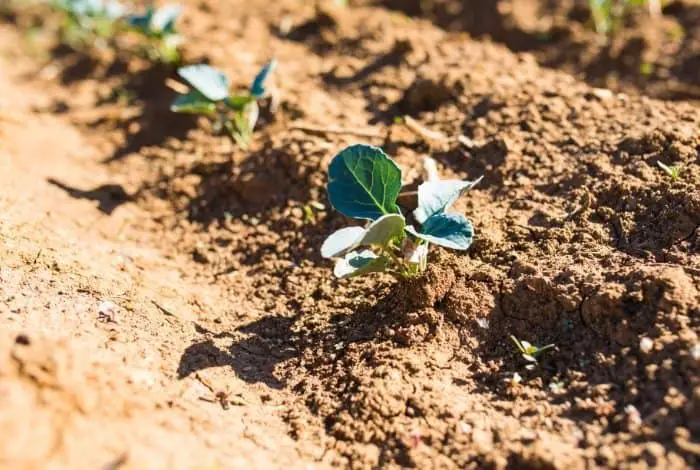Last Updated on October 26, 2022
Growing broccoli from seed is quite challenging for beginners but it’s not impossible for those who wish to learn how to do it.
Broccoli is a sun-loving crop that is best grown in the fall or spring. This beautiful good looking green belongs to the cabbage family. It is a close relative of cauliflower, cabbage, Brussels sprouts, and bok choy.
It is a cool weather plant that can yield one or two main harvests in a season. If properly cultivated, it can also yield mini-harvests per growing season. Once you harvest the main head, it will often keep producing smaller side shoots that you can enjoy for a long.
Brocolli is worth growing for its nutritional benefits. It is rich in vitamin A, potassium, iron, folic acid, and fiber.
Growing Broccoli From Seed Tips
Brocolli thrives in temperatures between 60 to 70 degrees Fahrenheit. Mature plants can thrive in cold temperatures of up to 25 degrees Fahrenheit.

This plant is also known to be temperamental! If you plant it too early, it produces small heads called buttons. If you plant it too late, the heads do not form at all, and plants flower and go to seed.
The best time to plant early in the spring season so that it will be ready for harvest when the hot weather arrives. You can also time the late spring season that will see plants mature in cool autumn weather.
Types of Broccoli Seeds To Grow
There are several types of broccoli seed varieties that you can grow. Some have larger heads while others have small. There are varieties that mature fast while others take longer. Some varieties even have purple heads.
Here are a few favorable types that you can work with:
- DIi Cicco – Classic Heirloom
- Summer purple – Larger heads
- Early heading – Early to mature
- Long harvest – Blend of early and late
- Santee F1 Purple – small but abundant
Broccoli Sprouting Seeds for Broccoli Sprouts & Microgreens
Read the Best way to germinate seeds in hydroponics
Step by Step Process Of Growing Broccoli From Seed
Requirements
- Your choice of broccoli seeds
- Water
- Pre-moistened soil or peat pellets
- Heat mat
How To Plan Broccoli Seeds
Step 1: Fill the seed trays with high-quality seed starting soil. Or use pre-moistened peat pellets if that’s what you prefer.
Step 2: Plant one seed per hole by making a shallow hole in the ready soil. Drop the seed into the shallow hole or place it on top and gently press it into the soil.
Step 3: Cover the seeds with soil and gently press down to ensure it comes into contact with the seeds. Since broccoli seeds are so small, they should be planted about 1/8” to ¼” deep.
Step 4: Water the planted seeds. It is best to water the trays from the bottom up so that the soil remains undisturbed. Simply pour water into the tray and allow the soil to soak it up from the bottom.
Step 5: Keep watering when necessary to ensure the soil doesn’t dry out as the seeds germinate.
FAQs
What are the steps to planting broccoli?
There are three main steps in growing broccoli. First, the plants are sown indoors in a seed-starting medium. Second, the seedlings are transplanted into soilless potting mix. Third, they are then transplanted to larger pots, and finally, to the field.
Seeds of broccoli are sown in a seed-starting medium. It's important to choose a seed starting medium that has a high nitrogen content and is free of any additives that may harm the seedlings. The seeds should be kept moist at all times and not allowed to dry out. When the seedlings are planted, they should be placed about 2 inches deep and about 2 inches apart in the potting mix. You can water your seedlings by placing them in a plastic bag, or by using an automatic watering system.
How deep should they be planted?
Try this Poke a hole in the soil about 12 inches deep and 3 inches wide. Fill the hole with seeds (they should be planted 4 inches apart). Cover them with dirt and water them well.
How can I lantanas brocolli?
A small, sunny pot (I like a 10 litre pot) A potting mix or compost The seed of your choice. I have used purple sprouting broccoli and mini sprouts (which are the same thing as broccoli mini sprouts).
You can use any other type of broccoli seed. A fine mesh sieve An old plastic drinking bottle with a hole in the bottom If you don’t have any of these items, you can buy them at your local nursery or garden centre.
Step 1: Preparing Your Seed Pot Before starting to grow broccoli from seed, you need to prepare your seed pot. The first thing that you need to do is to soak your seeds for two hours. This is important as it removes the protective coating on the seed. You can use a glass jar or bowl with some warm water to soak your seeds. If you are using a plastic container, make sure that you don’t leave your seeds in there for too long as they may dry out.
Step 2: Sowing Your Seeds The next step is to sow your seed into your seed pot.
To do this, sprinkle the seeds evenly over the surface of your pot and then gently pat down the top of the seeds to ensure that all the seeds are evenly distributed in the pot. This can take between three to five days depending on the temperature and the amount of light that you are giving them.
Step 3: Germinating Your Seeds Now that your seeds have germinated, it is time to transplant them into the soil. First, carefully remove all of the seedlings from your seed pot. You can use a pair of scissors or a small knife. Then, place the seedlings into individual pots or trays filled with a mixture of soil and sand. Make sure that the soil has a good amount of compost in it as this will help to support the young plants. Don’t add any fertiliser at this stage as it could harm the roots. When you have transplanted your seedlings, water them well. Do this every day until you see that they have started to grow their first true leaves.
Conclusion
Even though it sounds easy to grow broccoli, it does require some knowledge to get the best out of your seeds. You may not get it first but rest assured the second, third, and fourth times will not be a fail!

Lory is an avid gardener who loves spending time outdoors. She is passionate about using her green thumb to create beautiful, lush gardens for her friends and family. She finds joy in tending to her garden, trimming plants, and cultivating new species. She loves to share her knowledge and experience with others who have a similar enthusiasm for gardening. Lory is a true nature enthusiast who loves to share her enthusiasm for the outdoors with all who meet her.

